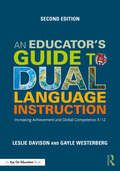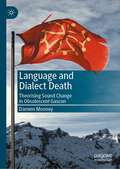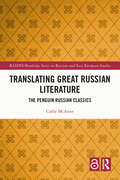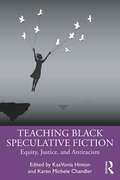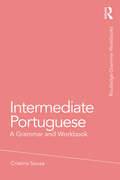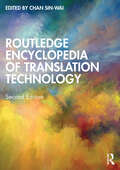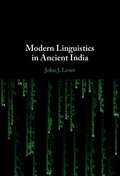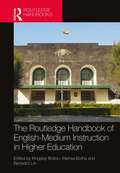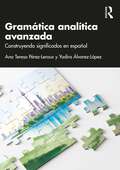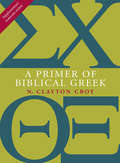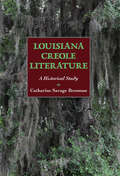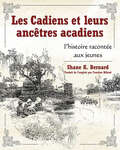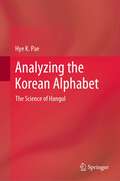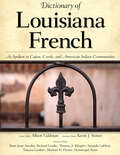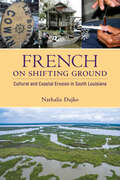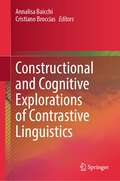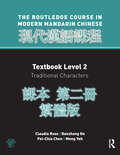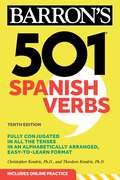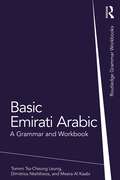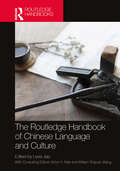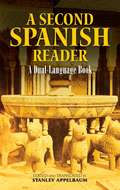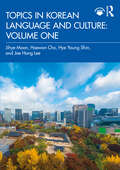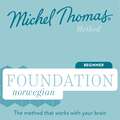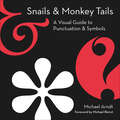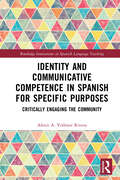- Table View
- List View
An Educator's Guide to Dual Language Instruction: Increasing Achievement and Global Competence, K–12
by Leslie Davison Gayle WesterbergComprehensively updated, the second edition is a user- friendly resource for teachers and administrators to ensure their school’s success in implementing and maintaining a dual language program. The book is filled with step-by-step instructions and strategies you can try immediately. The second edition includes key updates on technology, digital resources, and current demographics, standards, and data. Educators will learn how to choose a model for their dual language program involving all stakeholders in the transition process, set proficiency targets and use assessments to track progress, and much more.
Language and Dialect Death: Theorising Sound Change in Obsolescent Gascon
by Damien MooneyThis book offers a systematic acoustic phonetic analysis of both language and dialect death in the region of Béarn, southwestern France. Focusing on Béarnais, a localised dialect of Gascon which is under pressure from French, the author explores the socio-political process of language shift, whereby members of a speech community cease to speak their indigenous language in favour of an incoming dominant language. Gascon is at an advanced stage of this process, making its remaining speakers excellent candidates for the study of language obsolescence, and this unique study will be of interest to researchers working in a broad range of disciplines, including language variation and change, language and dialect contact, Occitan and French, sociophonetics and phonology.
Translating Great Russian Literature: The Penguin Russian Classics (ISSN)
by Cathy McAteerLaunched in 1950, Penguin’s Russian Classics quickly progressed to include translations of many great works of Russian literature and the series came to be regarded by readers, both academic and general, as the de facto provider of classic Russian literature in English translation, the legacy of which reputation resonates right up to the present day. Through an analysis of the individuals involved, their agendas, and their socio-cultural context, this book, based on extensive original research, examines how Penguin’s decisions and practices when translating and publishing the series played a significant role in deciding how Russian literature would be produced and marketed in English translation. As such the book represents a major contribution to Translation Studies, to the study of Russian literature, to book history and to the history of publishing.
Teaching Black Speculative Fiction: Equity, Justice, and Antiracism
by KaaVonia Hinton Karen Michele ChandlerTeaching Black Speculative Fiction: Equity, Justice, and Antiracism edited by KaaVonia Hinton and Karen Michele Chandler offers innovative approaches to teaching Black speculative fiction (e.g., science fiction, fantasy, horror) in ways that will inspire middle and high school students to think, talk, and write about issues of equity, justice, and antiracism. The book highlights texts by seminal authors such as Octavia E. Butler and influential and emerging authors, including Nnedi Okorafor, Kacen Callender, B. B. Alston, Tomi Adeyemi, and Bethany C. Morrow.Each chapter in Teaching Black Speculative Fiction: introduces a Black speculative text and its author, describes how the text engages with issues of equity, justice, and/or antiracism, explains and describes how one theory or approach helps elucidate the key text’s concern with equity, justice, and/or antiracism, and offers engaging teaching activities that encourage students to read the focal text; that facilitate exploration of the text and a theoretical lens or critical approach; and that guide students to consider ways to extend the focus on equity, justice, and/or antiracism to action in their own lives and communities.
Intermediate Portuguese: A Grammar and Workbook (Routledge Grammar Workbooks)
by Cristina SousaIntermediate Portuguese: A Grammar and Workbook is an accessible reference grammar presenting twenty-two individual grammar points in realistic contexts with practise exercises in each unit designed to reinforce and consolidate learning.This comprehensive volume takes a grammatical approach which encourages students to familiarise themselves with the grammar points in each unit, using a wide variety of contemporary vocabulary that can be applied to different settings such as work, shopping, tourism, business, education and socialising. Key features include: grammar exercises and a full answer key frequent comparative references to English grammar a list of key vocabulary at the end of each unit a glossary of grammatical terms Providing readers with the essential tools to express themselves in a wide variety of situations, Intermediate Portuguese is an essential resource for students with beginner to intermediate knowledge of the language and is suitable for both class-based learning and independent study.
Routledge Encyclopedia of Translation Technology
by Chan Sin-WaiRoutledge Encyclopedia of Translation Technology, second edition, provides a state-of-the-art survey of the field of computer-assisted translation. It is the first definitive reference to provide a comprehensive overview of the general, regional, and topical aspects of this increasingly significant area of study. The Encyclopedia is divided into three parts: Part 1 presents general issues in translation technology, such as its history and development, translator training, and various aspects of machine translation, including a valuable case study of its teaching at a major university; Part 2 discusses national and regional developments in translation technology, offering contributions covering the crucial territories of China, Canada, France, Hong Kong, Japan, South Africa, Taiwan, the Netherlands and Belgium, the United Kingdom, and the United States; Part 3 evaluates specific matters in translation technology, with entries focused on subjects such as alignment, concordancing, localization, online translation, and translation memory. The new edition has five additional chapters, with many chapters updated and revised, drawing on the expertise of over 50 contributors from around the world and an international panel of consultant editors to provide a selection of chapters on the most pertinent topics in the discipline. All the chapters are self-contained, extensively cross-referenced, and include useful and up-to-date references and information for further reading. It will be an invaluable reference work for anyone with a professional or academic interest in the subject.
Modern Linguistics in Ancient India
by null John J. LoweThe ancient Indian linguistic tradition has been influential in the development of modern linguistics, yet is not well known among modern Western linguists. This unique book addresses this gap by providing an accessible introduction to the Indian linguistic tradition, covering its most important achievements and ideas, and assessing its impact on Western linguistics. It shows how ancient Indian methods of linguistic analysis can be applied to a number of topical issues across the disciplines of modern linguistics–spanning phonetics, phonology, morphology, syntax, semantics, and computational linguistics. Exploring the parallels, differences, and connections in how both traditions treat major issues in linguistic science, it sheds new light on a number of topical issues in linguistic theory. Synthesizing existing major work on both sides, it makes Indian linguistics accessible to Western linguists for the first time, as well as making ideas from mainstream linguistics more accessible to students and scholars of Indian grammar.
The Routledge Handbook of English-Medium Instruction in Higher Education (Routledge Handbooks in Linguistics)
by Kingsley Bolton Werner Botha Benedict LinThis Handbook discusses the theoretical and disciplinary background to the study of English-medium instruction (EMI) in higher education worldwide. It highlights issues relating to EMI pedagogy, varying motivations for EMI education, and the delivery of EMI in diverse contexts across the world. The spread of English as a teaching medium and the lingua franca of the academic world has been the subject of various debates in recent years on the perceived hegemony of the English language and the ‘domain loss’ of non-English languages in academic communication. Encompassing a wide range of contributions to the field of EMI, the chapters of this Handbook are arranged in four distinct parts: Part I provides an overview of English-medium instruction in higher education worldwide; Part II focusses on EMI in Europe; Part III on EMI in the Middle East, North Africa, and Sub-Saharan Africa; and Part IV on EMI in the Asian region. The overall scope and level of expertise of this Handbook provides an unrivalled overview of this field of education. It serves as an essential reference for many courses dealing with applied linguistics, English language education, multilingualism, sociolinguistics, and related subjects at many levels of education, including Master’s and PhD-level studies. This Handbook serves as a valuable edition for university libraries across the world and an essential read for many faculty, undergraduate and postgraduate students, educators, and policymakers.
Gramática analítica avanzada: Construyendo significados en español (Analytic Grammars for Advanced Learners and Teachers)
by Ana Teresa Pérez-Leroux Yadira Álvarez-LópezLa Gramática analítica avanzada: Construyendo significados en español ofrece una cobertura descriptiva amplia de los temas gramaticales fundamentales del español, a la vez que proporciona un tratamiento detallado de las estrategias de análisis necesarias para que los lectores puedan desarrollar sus destrezas analíticas y su propio pensamiento gramatical. Esta gramática no asume conocimiento previo de la lingüística. Para ayudar al lector, los materiales están organizados desde los conceptos más básicos a los más complejos. Las herramientas analíticas que acompañan los diferentes temas pueden aplicarse a nuevos fenómenos que surjan durante el proceso de aprendizaje del español como segunda lengua, ofreciéndoles a los lectores la garantía de poder seguir aprendiendo. Cada capítulo contiene una síntesis, tablas de resumen y ejercicios que sirven para repasar los conceptos estudiados.La Gramática analítica avanzada será de utilidad tanto para los estudiantes avanzados de español como segunda lengua que busquen profundizar su comprensión de la gramática del español, así como para hablantes nativos y futuros maestros que deseen reforzar su conocimiento de los fundamentos de la gramática descriptiva.Gramática analítica avanzada: Construyendo significados en español provides a comprehensive descriptive coverage of core grammatical topics in the Spanish language while simultaneously offering an in-depth analytic treatment to support readers in developing their own grammatical thinking.This grammar assumes no previous familiarity with linguistics and organizes the materials from the more basic to more complex concepts to help readers understand the building blocks of the language. The analytic toolkit provided for the topics covered within the book can be applied to novel phenomena encountered in the second language acquisition process, setting readers up for lifelong independent learning. Each chapter includes a chapter summary, summary tables, and exercises to reinforce and review the concepts covered.Gramática analítica avanzada will be useful to advanced speakers of Spanish as a second language seeking to deepen their conscious understanding of Spanish grammar as well as native speakers and future teachers who wish to strengthen their foundational knowledge of descriptive grammar.
A Primer of Biblical Greek (Eerdmans Language Resources (ELR))
by N. Clayton CroyThough there are currently a number of texts for teaching biblical Greek, most of them are plagued by various deficiencies. Written with these flaws in mind, this new primer by N. Clayton Croy offers an effective, single-volume introduction to biblical Greek that has proven successful in classrooms around the country.This volume takes a primarily deductive approach to teaching biblical Greek and assumes that students have no prior knowledge of the language. Divided into 32 separate lessons, each containing a generous number of exercises, the text leads students from the Greek alphabet to a working understanding of the language of the Septuagint and the New Testament.Special features of A Primer of Biblical Greek:An abundance of exercisesEach lesson includes practice sentences taken from the Septuagint and the New Testament as well as Greek sentences composed by the author. Exercises in English-to-Greek translation are also included.Concise but accurate grammatical explanationsGreat care has been taken to insure that grammatical explanations are clear, correct, and succinct. In particular, the Greek participle receives a fuller-than-usual treatment.A natural order of presentationMaterial is presented according to the natural structure of Greek and the traditional terminology of grammarians. Declensions and principal parts, for example, are presented in numerical order.Inclusive languageThe book uses inclusive language for human beings throughout.Helpful appendixes for quick referenceIncluded at the back of the book are the Greek paradigms, Greek-to-English vocabulary, English-to-Greek vocabulary, and a bibliography for further study.
Louisiana Creole Literature: A Historical Study
by Catharine Savage BrosmanLouisiana Creole Literature is a broad-ranging critical reading of belles lettres—in both French and English—connected to and generally produced by the distinctive Louisiana Creole peoples, chiefly in the southeastern part of the state. The book covers primarily the nineteenth and twentieth centuries, the flourishing period during which the term Creole had broad and contested cultural reference in Louisiana. The study consists in part of literary history and biography. When available and appropriate, each discussion—arranged chronologically—provides pertinent personal information on authors, as well as publishing facts. Readers will find also summaries and evaluation of key texts, some virtually unknown, others of difficult access. Brosman illuminates the biographies and works of Kate Chopin, Lafcadio Hearn, George Washington Cable, Grace King, and Adolphe Duhart, among others. In addition, she challenges views that appear to be skewed regarding canon formation. The book places emphasis on poetry and fiction, reaching from early nineteenth-century writing through the twentieth century to selected works by poets still writing in the early twenty-first century. A few plays are treated also, especially by Victor Séjour. Louisiana Creole Literature examines at length the writings of important Francophone figures, and certain Anglophone novelists likewise receive extended treatment. Since much of nineteenth-century Louisiana literature was transnational, the book considers Creole-based works which appeared in Paris as well as those published locally.
Les Cadiens et leurs ancêtres acadiens: l'histoire racontée aux jeunes
by Shane K. BernardCajuns and Their Acadian Ancestors: A Young Reader's History traces the four-hundred-year history of this distinct American ethnic group. In its original English, the book proved a perfect package, comprehensible to junior-high and high-school students, while appealing to and informing adult readers seeking a one-volume exploration of these remarkable people and their predecessors. It is now available for the first time translated into French. The narrative follows the Cajuns' early ancestors, the Acadians, from seventeenth-century France to Nova Scotia, where they flourished until British soldiers expelled them in a tragic event called Le Grand Dérangement (The Great Upheaval)—an episode regarded by many historians as an instance of ethnic cleansing or genocide. Up to one-half of the Acadian population died from disease, starvation, exposure, or outright violence in the expulsion. Nearly three thousand survivors journeyed through the thirteen American colonies to Spanish-controlled Louisiana. There they resettled, intermarried with members of the local population, and evolved into the Cajun people, who today number over a half-million. Since their arrival in Louisiana, the Cajuns have developed an unmistakable identity and a strong sense of ethnic pride. In recent decades they have contributed their lively cuisine and accordion-and-fiddle dance music to American popular culture. Les Cadiens et leurs ancêtres acadiens: l'histoire racontée aux jeunes includes numerous images and over a dozen sidebars on topics ranging from Cajun music and horse racing heroes to Mardi Gras. Shane K. Bernard's welcomed and cherished history of the Cajun people is translated into French by Faustine Hillard. The book offers a long-sought immersion text, ideal for the young learner and adult alike. Intended to appeal to both native French-speakers as well as to English-speaking students who are learning French, this French translation of Shane K. Bernard's Cajuns and Their Acadian Ancestors: A Young Reader's History is perfect for middle-school and high-school readers enrolled in conversational and French Immersion classes. Adult readers of French will also find it a useful primer of Acadian and Cajun history. Les Cadiens et leurs ancêtres acadiens : l'histoire racontée aux jeunes retrace le périple de quatre siècles de ce groupe ethnique nord-américain distinct des autres. Accessible aux adolescents, ce volume s'avérera également utile et pratique pour le lecteur adulte qui cherche à connaître à la fois ce peuple remarquable et ses ancêtres. Le récit suit la trace des Acadiens, les premiers ancêtres des Cadiens, de la France du dix-septième siècle à la Nouvelle-Écosse, là où ils se sont épanouis jusqu'à ce que des soldats britanniques les expulsent lors de cet évènement tragique que fut Le grand dérangement—un triste épisode qui a débuté en 1755 et que nombre d'historiens modernes considèrent comme un parfait exemple de nettoyage ethnique, voire de génocide. Près de trois mille survivants ont (péniblement) traversé les treize colonies américaines pour se rendre jusqu'en Louisiane, alors sous le régime espagnol. Là, ils s'installent à nouveau, s'intègrent à la population locale par le biais du mariage et forment peu à peu ce qu'il est aujourd'hui convenu d'appeler le peuple cadien. Aujourd'hui, on compte plus d'un demi-million d'habitants d'origine cadienne en Louisiane.
Analyzing the Korean Alphabet: The Science of Hangul
by Hye K. PaeThis book provides comprehensive coverage of the Korean alphabet, Hangul, and includes a synthesis of research findings relating to reading in the non-Roman alphabet. This, in turn, contributes to the science of reading through an understanding of reading mechanisms that are essential for all writing systems, and that are particular for a given writing system. Hangul has been recognized as “the world’s best alphabet,” “one of the great intellectual achievements of Mankind,” and “alphabet’s epitome, a star among alphabets” by international linguists and historians. It is known that writing systems have evolved based on the ecological principle that visual signs are culturally selected to match objects found in natural scenes through selection pressures for optimal visual processing. However, Hangul is an exception. It was purposely invented by King Sejong in the 15th century to combat the illiteracy prevalent at the time. The chapters excavate the historical background of Hangul, and the unique characteristics of Hangul that contribute to learnability for emergent readers and efficiency for skilled readers. The author presents empirical evidence of psycholinguistic research into reading Hangul, building theories and presenting implications for the science of reading (psycholinguistics) and the science of writing (grapholinguistics). This book is relevant to students, researchers, and practitioners in applied linguistics, psycholinguistics, language studies, reading studies, and grammatology, with a particular focus on the Korean alphabet.
Dictionary of Louisiana French: As Spoken in Cajun, Creole, and American Indian Communities
by Barry Jean Ancelet Richard Guidry Thomas A. Klingler Amanda LaFleur Tamara Lindner Michael D. Picone Dominique RyonThe Dictionary of Louisiana French (DLF) provides the richest inventory of French vocabulary in Louisiana and reflects precisely the speech of the period from 1930 to the present. This dictionary describes the current usage of French-speaking peoples in the five broad regions of South Louisiana: the coastal marshes, the banks of the Mississippi River, the central area, the north, and the western prairie. Data were collected during interviews from at least five persons in each of twenty-four areas in these regions. In addition to the data collected from fieldwork, the dictionary contains material compiled from existing lexical inventories, from texts published after 1930, and from archival recordings. The new authoritative resource, the DLF not only contains the largest number of words and expressions but also provides the most complete information available for each entry. Entries include the word in the conventional French spelling, the pronunciation (including attested variants), the part of speech classification, the English equivalent, and the word's use in common phrases. The DLF features a wealth of illustrative examples derived from fieldwork and textual sources and identification of the parish where the entry was collected or the source from which it was compiled. An English-to-Louisiana French index enables readers to find out how particular notions would be expressed in la Louisiane.
French on Shifting Ground: Cultural and Coastal Erosion in South Louisiana (America's Third Coast Series)
by Nathalie DajkoIn French on Shifting Ground: Cultural and Coastal Erosion in South Louisiana, Nathalie Dajko introduces readers to the lower Lafourche Basin, Louisiana, where the land, a language, and a way of life are at risk due to climate change, environmental disaster, and coastal erosion. Louisiana French is endangered all around the state, but in the lower Lafourche Basin the shift to English is accompanied by the equally rapid disappearance of the land on which its speakers live. French on Shifting Ground allows both scholars and the general public to get an overview of how rich and diverse the French language in Louisiana is, and serves as a key reminder that Louisiana serves as a prime repository for Native and heritage languages, ranking among the strongest preservation regions in the southern and eastern US. Nathalie Dajko outlines the development of French in the region, highlighting the features that make it unique in the world and including the first published comparison of the way it is spoken by the local American Indian and Cajun populations. She then weaves together evidence from multiple lines of linguistic research, years of extensive participant observation, and personal narratives from the residents themselves to illustrate the ways in which language—in this case French—is as fundamental to the creation of place as is the physical landscape. It is a story at once scholarly and personal: the loss of the land and the concomitant loss of the language have implications for the academic community as well as for the people whose cultures—and identities—are literally at stake.
Constructional and Cognitive Explorations of Contrastive Linguistics
by Annalisa Baicchi Cristiano BrocciasThis book approaches the field of contrastive linguistics from a comparative and robust perspective that combines the tenets of construction grammar and cognitive linguistics. In doing so, it shows how their integration can help to successfully enhance research on contrastivity, by means of updated theoretical frameworks and applied methodologies that combine language and thought. It compares ten different languages and offers analyses of constructions at all levels of the linguistic organization, identifying the cognitive motivations that instantiate the linguistic data retrieved from corpora. Relevant to both cognitive and non-cognitive linguists interested in variation and contrastive approaches, as well as graduate students in these areas, this book makes a significant contribution to existing work on the various types of constructional and discourse-based phenomena in modern languages.
Routledge Course in Modern Mandarin Chinese Level 2 Traditional: The Routledge Course Textbook Level 1 (Modern Grammars Ser.)
by Claudia Ross Baozhang He Pei-chia Chen Meng YehThe Routledge Course in Mandarin Chinese is a two-year undergraduate course for students with no prior background in Chinese study. Designed to build a strong foundation in both the spoken and written language it develops all the basic skills such as pronunciation, character writing, word use and structures, while placing strong emphasis on the development of communicative skills.The complete course consists of Textbook Level 1, Workbook level 1 - including free CDs, Textbook level 2 and workbook level 2 -including free CDs. All books are available separately in simplified as well as traditional characters and take the students from complete beginner to post-intermediate level. Textbook Level 2 incorporates the innovative features of Level 1 including the separation of vocabulary from characters, a "basic to complex" introduction of grammatical structures, a comprehensive companion workbook with extensive practice in all language skills and functions, and a Teachers’ Manual. Level 2 adds a "Narrative" Component to support the learner as they move from spoken Mandarin to formal written Chinese, and from the comprehension and production of short sentences to paragraphs and essays. Level 2 of this Course in Modern Mandarin bridges the gap that characterizes the transition between basic level Chinese courses and more advanced work. The Narrative Component includes: Model narratives that introduce formal written Chinese with explanations of the features of each narrative Focus on narrative function including description, comparison, explanation, persuasion, and hypothesis Reading and writing assignments that guide students to internalize model structures, to read for information, and to compose original essays for specific purposes. The course is also fully supported by an interactive companion website which contains a wealth of additional resources for both teachers and students. Teachers will find lesson plans in both English and Mandarin, providing a weekly schedule and overall syllabus for fall and spring, as well as activities for each lesson and answer keys Students will be able to access downloadable character practice worksheets along with interactive pronunciation, vocabulary and character practice exercises. All the audio material necessary for the course is also available online and conveniently linked on screen to the relevant exercises for ease-of-use For more information about the course and to access these additional resources, please visit the companion website at www.routledge.com/textbooks/9780415472517For bundle discounts please visit: http://www.routledge.com/books/details/9780415533089/
501 Spanish Verbs, Tenth Edition (Barron's 501 Verbs)
by Christopher Kendris Theodore KendrisChoose Barron&’s 501 Spanish Verbs for language learning--a trusted resource for over 50 years! This edition provides language learners with fingertip access to a carefully curated selection of the 501 most common Spanish verbs--in all tenses and moods! It is the perfect companion for students in high-school and college-level courses, or for anyone who wants to self-study. Each verb is listed alphabetically in chart form—one verb per page along with its English translation, present participle, and gerundio. Follow the clear, concise instruction, and then take your language fluency to the next level with an online activity center. Comprehensive Language Learning Lists of synonyms, antonyms, idioms, and usage examples for every verb A concise grammar review of tricky topics, organized for easy reference The popular 55 Essential Verbs feature, with an in-depth look at usage and formation for the most useful and challenging Spanish verbs Over 2,300 additional verbs conjugated like the 501 models English-Spanish Verb Index Numerous other features, such as: a pronunciation guide, weather expressions, subjunctive mood, defective and impersonal verbs, verbs that take prepositions, reflexive and reciprocal verbs, and more More Practice Online Audio program modeling native speaker rhythms and pronunciation Listening comprehension 4 practice quizzes with detailed answer explanations and auto scoring
Basic Emirati Arabic: A Grammar and Workbook (Routledge Grammar Workbooks)
by Tommi Tsz-Cheung Leung Dimitrios Ntelitheos Meera Al KaabiBasic Emirati Arabic: A Grammar and Workbook is an elementary-level grammar book of the variety of Gulf Arabic spoken in the United Arab Emirates.In this book, a series of compact units provide brief and concise descriptions of the fundamental grammatical structures, accompanied by examples drawn from Emirati native language speakers and several exercises assessing the learner’s understanding and mastery of the grammatical structure discussed. A key to these exercises is also provided so that learners can self-assess their progress and obtain immediate feedback.This book is intended for beginner learners who would like to engage with this variety of Arabic and learn its basic grammatical structure through practice. It is additionally a valuable tool for language teachers of Emirati and Gulf Arabic as well as learners of Modern Standard Arabic who would like access to a basic reference of the dialect.
The Routledge Handbook of Chinese Language and Culture (Routledge Language Handbooks)
by Liwei Jiao Victor H. Mair William Shiyuan WangThe Routledge Handbook of Chinese Language and Culture represents the first English anthology that delves into the fascinating and thought-provoking relationship between the Chinese language and culture, exploring various macro and micro perspectives.Chinese culture boasts a history of ten thousand years, while the Chinese language’s recorded history spans at least three thousand years, dating back to the Shang dynasty oracle bone inscriptions (OBI).This handbook is comprised of 17 chapters from 18 scholars including Victor Mair and William S-Y. Wang. Many chapters approach their respective topics with a comprehensive and historical outlook. Certain extensive subjects are addressed in multiple chapters, complementing one another. These topics include: The languages and peoples of China, and the southern Chinese dialects Mandarin’s evolution into a national language and its related writing reforms Language as a propaganda tool in the Cultural Revolution and in contemporary China Chinese idioms and colloquialisms This book offers an approachable exploration of the subject, appealing to both specialists and enthusiasts of the Chinese language and culture.
A Second Spanish Reader: A Dual-Language Book (Dover Dual Language Spanish)
by Stanley AppelbaumGeared toward advanced beginners, this dual-language volume offers the convenient, accessible format of English translations on pages facing the matching Spanish text. It introduces such authors as Lope de Vega, Cervantes, Alarcón, Unamuno, and Darío, and such works as El buscón, Cartas marruecas, El estudiante de Salamanca, and Santa. Contents include plays, lyric and narrative verse, and prose of many kinds — fiction, philosophy, autobiography, and more — for a generous sampling of the Spanish language's extraordinarily diverse and rich literary history.The selections begin at around 1550, at the outset of the 100 years known as the Golden Age. Excerpts from the era's major genres and authors include the works of three prominent playwrights, plus pastoral and picaresque novels, religious meditations, and a report from the New World. Three outstanding exponents of the Enlightenment appear here, in addition to contributions from the major Romantic playwrights and poets, several Realist and Naturalist novelists, and the pillars of the Generation of 1898. One-third of the selections are the works of Spanish-American writers. Accurate and up to date, this new translation by Stanley Appelbaum features a detailed Introduction with background on all of the writers and their works.
Topics in Korean Language and Culture: Volume One
by Jihye Moon Haewon Cho Hye Young Shin Jae Hong LeeTopics in Korean Language and Culture: Volume One covers 12 essential topics relating to both traditional and contemporary Korean culture and society.Each chapter consists of listening and reading passages, key expressions and grammar, and performance-based activities unfolding across different modes of oral and written communication. The grammar section is organized into foundation review, semantic distinction, and language function to help learners advance beyond the plateau of intermediate proficiency. All passages are carefully written to resemble authentic texts used by Korean native speakers and to include various text types and speech styles that learners will encounter in real life.The first volume specifically targets students in their third year of learning Korean. It is designed to accommodate a wide range of courses and curricula existing for Korean programs today. It is intended for a yearlong language sequence as well as an intensive topic course in speaking, reading, or writing.
Foundation Norwegian (Michel Thomas Method) - Full course: Learn Norwegian with the Michel Thomas Method
by Michel Thomas Angela Shury-Smith'The thrill is that you're actually figuring it out on your own. You're engaging with another language, not just parroting it... It's an excellent way to start, and leaves the listener thinking, Hey, Ich kann do dis.' - New Yorker, David Sedaris, humorist and author, on learning German with the Michel Thomas Method Looking for a convenient language course that fits your lifestyle and gets you speaking a new language in a matter of weeks, not years? The original no-books, no-homework, no-memorizing method is in tune with the way the brain prefers to receive, store and retrieve information. You'll stick with it because you'll love it. * Pick up Norwegian naturally and unforgettably without strain or stress * Learn from listening and speaking, without the pressure of writing or memorizing * Build up your Norwegian in manageable steps by thinking out answers for yourself WHY IS THE METHOD SO SUCCESSFUL? 'What you understand, you know; and what you know, you don't forget.' - Michel Thomas Before there were algorithms, there was Michel Thomas. For over 50 years he worked on decoding languages by breaking them down into their most essential component parts. These 'building blocks' are introduced to the learner sequentially in such a way that you reconstruct the language for yourself - to form your own sentences, to say what you want, when you want. This unique method draws on the principles of instructional psychology and works with the way your brain prefers to receive, store and retrieve information. Knowledge is structured and organized so that you absorb the language easily and don't forget it. The method is designed to eliminate the stress which prevents you from relaxing and allowing the brain to work in the way which accepts learning in a seemingly painless, very exciting and highly motivating way. HOW DO THE COURSES WORK? 'All stress inhibits true and effective learning' - Michel Thomas During the course, you will join Michel Thomas Method teacher Angela Shury-Smith and two students in a live lesson, learning from both their successes and their mistakes to keep you motivated and involved throughout the course. You, as the learner, become the third student and participate actively in the class. Within the very first hour you will be able to construct simple phrases by listening and thinking out answers for yourself without the pressure of writing or stress of having to memorize. You will learn at your own pace, pausing and repeating where necessary, and complete the course in about 20-30 hours. By the end of the course, you will understand and have the confidence to speak basic Norwegian. WHAT WILL I ACTUALLY ACHIEVE? 'I am the architect who builds the house. It's up to you to decorate it.' - Michel Thomas The Michel Thomas Method will help you kick-start, continue, and flourish in your Norwegian language learning journey. It is not intended to get you perfectly fluent, but it will get you speaking and using Norwegian, with proper pronunciation, faster than any other method. It is designed to give you a strong foundation and good working knowledge of a language from which you can expand and later 'add decoration' to. It is a rapid method for learning, that requires only concentration on the part of the learner. LEARN ANYWHERE! Reclaim your pockets of free time to learn a new language! Don't be tied to chunky books or your computer, Michel Thomas Method audio courses let you learn whenever and wherever you want, in as little or as much time as you have. WHAT IS NEXT? After Foundation, we recommend doing the Language Builder or Intermediate course. Generally, this is the recommended order for the Michel Thomas Method language courses: 1. Foundation 2. Language Builder 3. Intermediate 4. Vocabulary
Snails & Monkey Tails: A Visual Guide to Punctuation & Symbols
by Michael Arndt"There are countless books that can teach you the alphabet, but almost none that focus on the tiny designs that run interference among the letterforms: those easily overlooked punctuation and typographic symbols. These symbols, as Michael Arndt proves in this beautiful and endlessly fascinating book, are absolutely indispensable to communication: punctuation turns words into sentences and language into meaning... From commas to semicolons, from slashes to asterisks, from guillemets to octothorpes (named, perhaps, after athlete Jim Thorpe), you’ll never look at punctuation the same way again."—Michael Bierut, partner, PentagramIn this show-stopping guide with more than 75 uniquely designed two-color spreads—a rollicking linguistic ride for fans of Eats, Shoots & Leaves and Just My Type—award-winning graphic designer Michael Arndt explores the typographic origins, names, and shapes of both common punctuation marks and symbols, as well as the proper and diverse usage of each.From the period to the question mark, the semicolon to the em dash, symbols and marks are an integral part of language. In graphically engaging spreads that utilize typography in an innovative way, Snails & Monkey Tails examines the evolution of these mighty linguistic tools—from the punctum, or point, created by an ancient scribe to the guillemet, used most commonly in lieu of quote marks by the French (and named in honor of a typographer Guillaume Le Bé). With verve and insight, Michael Arndt explains their proper usage and how they came to be universally accepted today. Snails & Monkey Tails—Snails (@); Monkey Tails (&)—is packed with intriguing facts, history, stories, and lore, as well as grammar, explaining it clearly and with examples. What is the purpose of the comma—perhaps the most used symbol in the English language—and what are the proper uses of the asterisk? Do quote marks go inside or outside punctuation? What about a quote within a quote—a quote from someone quoting someone else? How much space goes on either side of an ellipsis? What’s the difference between an en-dash and an em-dash? Complete with a listing of useful terms and clear diagrams for creating typographical marks and symbols correctly on both PC and Apple computers, Snails & Monkey Tails is essential for bibliophiles, writers, grammarians, graphic designers, typography enthusiasts, logophiles, and anyone with a passion for the written word.
Identity and Communicative Competence in Spanish for Specific Purposes: Critically Engaging the Community (Routledge Innovations in Spanish Language Teaching)
by Alexis A. Vollmer RiveraIdentity and Communicative Competence in Spanish for Specific Purposes analyzes the experiences of three Spanish for specific purposes (SSP) students, offering insight into the intersectionality of society, politics, identity, and linguistics in community-based settings.Analyses provide empirical evidence to a growing body of work about how experiential language learning (EX-LL) enhances student preparation to utilize target languages in professional services. Ethnographic portraits and discourse analysis also illustrate how EX-LL, such as internships, provides students with opportunities to position and protect their identities using linguistic and extralinguistic resources. Discussions are presented throughout the volume on how to implement EX-LL from a critical perspective that supports students while mutually benefiting community members. Harnessing community members’ stories to contextualise and illustrate the disparities U.S. Hispanic/Latinx communities face in accessing high-quality care and services, the volume proposes SSP as a form of advocacy to narrow this gap while simultaneously enhancing students’ skills in Spanish.Designed for graduate students, educators, researchers, and program developers in SSP, second language acquisition, heritage language pedagogy, and sociolinguistics, this volume will prompt the reader to (re)imagine how language learning traverses society, politics, and identity in community-based settings.
